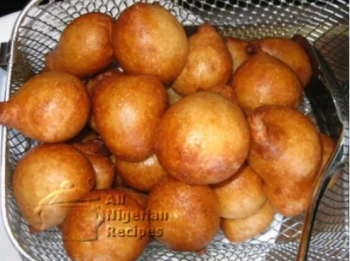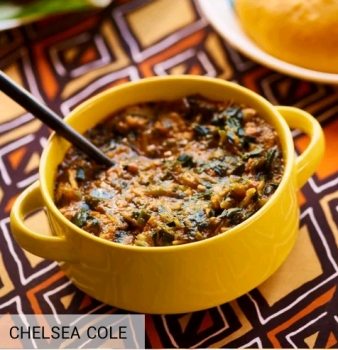profile/3955FB_IMG_16103234496236449.jpg
Ikenna44

How To Prepare Purf Purf
~2.9 mins read
Nigerian Puff Puff is that spongy, deep-fried, spherical snack that originated from Nigeria. It is soft and springs back to touch, you know, like when you pinch a foam sponge.
Click the following links for more Nigerian Puff Puff recipes:
How to Make Nigerian Puff Puff [Video]
Peppered Puff Puff
Easiest Nigerian Puff Puff Recipe
We leave it to our Nigerian brothers and sisters in the United States to tell you how tasty and special this Nigerian snack recipe is. Over there, it is rare to go to a party and not eat the Nigerian Puff Puff.
Making the Puff Puff recipe is both easy and complicated. Easy because the mixing is quite straight-forward and you will see proof that you are doing things right as you go along. It is only complicated when you do not follow the steps as detailed on this website. If this still fails, click here for the Easiest Nigerian Puff Puff Recipe .
Ingredients
For about 25 balls of Puff Puff, the size in the photo above, you will need:
2 cups (250g) of Plain Flour
2 teaspoons of yeast (the one used in baking bread)
½ teaspoon ground nutmeg
½ cup granulated sugar (or to your taste)
3 pinches of salt
Lukewarm water (for mixing)
Vegetable Oil (for frying)
Before you make the Nigerian Puff Puff
If your yeast is the type that looks like tiny pebbles or is like paste, mix it with lukewarm water and set aside. you will add it later when you have added water to the Puff Puff mix. If your yeast is in powder form, then add it when you add the other dry ingredients to the flour (as mentioned below).
Directions
1. Put the flour in a bowl, add the ground nutmeg, powdered yeast, sugar and salt. Mix all these together.
2. Add water in small quantities and mix everything by hand till you have a good blend of all the ingredients. Add the yeast you mixed with lukewarm water if applicable. Use warm water to mix the puff puff ingredients if you want it to rise faster.
3. Keep mixing till the batter is smooth but not too watery to flow from a spoon. The mix should be much thicker than pancake batter (see video below).
4. Cover the bowl with aluminum foil and make sure it is airtight by pressing the edges of the bowl (see video).
5. Leave to rise for about 45 minutes. When OK to fry, the Puff Puff batter should have risen in quantity and will have some air bubbles.
6. Pour some oil in a deep pot and allow to heat up. It's not advisable to use a deep fryer for Puff Puff because of the netting but if you want to use it, set the temperature to 170°C.
Note: The oil should be at least 3 inches deep. This is so that the puff puff will become spherical when scooped into the oil. You don't want to end up with flat
Pancakes. lol
7. Test that the oil is hot enough by putting a drop of batter into the oil. If it sizzles and comes up to the surface of the oil, then the oil is hot enough. If the oil is not hot enough, the batter will go down to the bottom of the oil and stay there.
8. When the oil is hot enough, scoop some batter into the oil with your hand by pressing the batter to come out from between your thumb and index finger. You should see the video for this technique as this is what will make your Puff Puff have a near-perfect spherical shape.
9. Put in more scoops of the batter, as much as the space in the frying pot will allow without overcrowding.
10. Once the underside of the puff puff has turned golden brown, flip the ball so that the topside will be fried as well.
11. When both sides are golden brown, take out the puff puff balls and place in a sieve. If you want to reduce the oil on your Puff Puff as much as possible, then line your sieve with paper towels. The paper towels help soak away the excess oil on the puff puff.
That's how the Nigerian Puff Puff is made. Serve with a chilled drink. Feel free to top it up with jam and other condiments you normally eat doughnuts with.
profile/3955FB_IMG_16103234496236449.jpg
Ikenna44

Spicy Okra And Spinach Stew
~1.0 mins read
This nourishing, cozy stew from Chef Fatou Ouattara of Akadi PDX in Portland, OR, will warm you up from the inside out.
YIELDS: 4 servings
TOTAL TIME: 0 hours 30 mins
INGREDIENTS
3 tbsp. palm oil (or coconut or avocado oil)
2 tsp. tomato paste (if not using palm oil)
2 tsp. Akadi sauce (see tip below) or hot sauce of choice
2 tsp. smoked paprika
2 tsp. onion powder
2 tsp. garlic powder
1 tsp. pink Himalayan sea salt
4 c. chopped okra (about 1 pound fresh, or use frozen okra, thawed)
2 c. packed spinach, collard greens, or kale
Rice, yam fufu, boiled or fried plantain, or boiled cassava, for serving
DIRECTIONS
WD Test Kitchen Tip: Akadi sauce: To make a similar sauce, puree 1 habañero chile, 1 plum tomato, ¼ small onion, and 1 small clove garlic (all chopped) along with 1 tsp grated ginger.
CHELSEA COLE
ADVERTISEMENT - CONTINUE READING BELOW
Heat oil in nonstick saucepan on medium-low. Add tomato paste and cook, stirring frequently, until tomato paste starts to dissolve and darkens in color, about 5 minutes.
1
Stir in Akadi sauce, smoked paprika, onion powder, garlic powder, and salt. Cook, stirring occasionally, until mixture is fragrant and forms a paste, 6 to 10 minutes.
2
Stir in okra, spinach, and 1/2 to 3/4 cup water (depending on how thick you want the stew to be) and simmer until okra is tender and liquid has reduced slightly, about 10 minutes. (Chef’s tip: If you don’t like the gelatinous texture of the okra, cover and cook 20 minutes.) Serve with rice, yam fufu, boiled or fried plantain, or boiled cassava.
Advertisement

Link socials
Matches
Loading...
